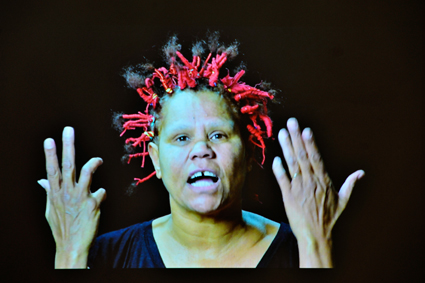Art and reclamation
Chris Reid: Bound and Unbound: Sovereign Acts

Faye Rosas Blanch, It’s so Hip to be BLAK, 2014
photo Denys Finney
Faye Rosas Blanch, It’s so Hip to be BLAK, 2014
Above Adelaide’s Fontanelle Gallery is a banner saying, “Occupied and Enjoyed.” The gallery is being occupied by a group of artists staging Bound and Unbound: Sovereign Acts—decolonising methodologies of the lived and spoken. As we arrive at the exhibition, attendants in lab coats ask us to sign a register—we are now under surveillance.
Bound and Unbound is a group exhibition of videos, texts, a ceiling-high stack of books, a field of red sand representing desert country, family photos and a representation of a traditional bush camp. But the key elements are the performances and the key issue is the exhibition’s agenda.
Performers Ali Gumillya Baker, Simone Ulalka Tur, Faye Rosas Blanche and Natalie Harkin are lecturers at Flinders University’s Yunggorendi First Nations Centre for Higher Education and Research, which provides support for Indigenous students at the university, engages in Indigenous research and education and is involved in communities of practice.
Bound and Unbound curator Baker also has her studio at Fontanelle. In the exhibition press release, she writes, “This experimental work aims to explore complex ideas of being both bound and free; what we are bound to historically and, as sovereign people, what we choose to (un)bind ourselves to and from, both now and into the future. The core themes include: interrogations of State colonial archives; notions of ethical practice and responsibility; enacting memory and storytelling; and sovereign identity and (re)representation.”
The performances are powerful and eloquent: Baker announces the exhibition’s aims; Yunggorendi Director Simone Ulalka Tur sings, accompanied by her niece Katie Inawantji Morrison on violin, and reads her mother’s poetry. Poet Natalie Harkin pastes up a text on the wall that reads, “Attention record keepers of the State we have you under surveillance!” referring to the surveillance of Indigenous people during South Australia’s colonial history and the retention of records of Indigenous communities held in the State Archives. Baker tells me that she needed written permission to access her family’s records, having had to sign a confidentiality agreement, and that Indigenous South Australians still feel under surveillance as if outside the community. Her video Archive Fever Paradox, of a performance by Harkin, also addresses the issue of the Archives, and her video of Tur and Blanche’s My Pen is My Weapon announces the group’s philosophy.
The family photographs recall and honour ancestors. The books in the stack are anthropological texts concerning the habits and nature of Indigenous people and their history. Baker declares these books racist; the artists’ intention is to address what has been written about Indigenous people in order to reclaim their history, change the way in which Indigenous people are understood and to re-present themselves. She cites Judith Butler’s concept of subjection and the process of becoming a subject of power as indicative of the colonial past and notes that Indigenous people are still defined racially. Their artwork is about how representations of Indigenous people still shape the lives of these people and our perceptions of them.
This is activist, community art. When viewers at the exhibition register on entry, they will subconsciously identify as Indigenous or otherwise and implicitly are asked whether they are in solidarity. The group demands decolonisation, reclaims Indigenous sovereignty and seeks mutual respect, inclusion and understanding. Indigenous people in SA lived under the Aborigines Act and this exhibition represents a symbolic emergence from it — to become unbound.
Baker and Tur tell me they are undertaking an educative process that is intended to complement their roles as lecturers at Yunggorendi. They teach Indigenous culture to non-indigenous university students and the artistic material they have developed will be used in their teaching. Using Fontanelle for the exhibition allows them to step outside their university roles and to develop their art in a space that supports experimental and interdisciplinary artwork. They use the space to promote dialogue between cultures and across art forms—theatre, installation, video, poetry—and they are interested in how experimental art might be used, citing as influences Richard Bell and the proppaNOW collective. It is a transforming experience for the artists themselves—they are undertaking PhDs and will use this experience in thinking through their research.
Bound and Unbound is described as Act 1 in a project that is planned to continue into 2015 with the production of further videos and possibly street art in key locations. It forms part of a broader project including the Tall Ships performance (recorded on video by Baker) at the opening of the Historia group exhibition, Adelaide Town Hall, earlier this year, which reconsidered Adelaide’s history.
Bound and Unbound: Sovereign Acts—decolonising methodologies of the lived and spoken, Ali Gumillya Baker (curator), Simone Ulalka Tur, Faye Rosas Blanch, Natalie Harkin, Fontanelle Gallery, Adelaide, 24 Aug-21 Sept
RealTime issue #123 Oct-Nov 2014 pg. 53






